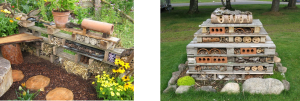


What types of habitats are needed to conserve our pollinators and other insects?
Dead wood is an increasingly rare habitat because in recent times we have become excessive with neatness in our gardens, parks and amenity areas. It is essential for the larvae of wood-boring beetles such as the stag beetle because they feast on the decaying wood. Place at the base of your hotel so the logs stay nice and damp and mix with other decaying plant matter to attract centipedes (which devour slugs) and other woodland litter insects such as millipedes and woodlice (which will provide a welcome source of food for birds). This is also a great spot for garden spiders.It also supports many fungi, which help break down the woody material.
Holes for Solitary Bees: There are many different species of solitary bee and all are excellent pollinators. The female bee lays an egg on top of a mass of pollen at the end of a hollow tube, she then seals the entrance with a plug of mud. A long tube can hold several eggs. Hollow stems, bamboo canes or holes drilled in blocks of wood make great habitats for the solitary bees. When it comes to drilling holes in wood, take into consideration the fact that different bee species are drawn to different sizes of holes for shelter and egg-laying and remember to use wood that is preservative free. As mentioned above you can make a home for solitary bees by collecting hollow stemmed canes and placing them in plastic bottles or lengths of drain pipe. You can also build a wooden shelter similar to a bird box. Solitary bees like warmth, so place your habitat in a sunny spot.
Straw and hay: These provide many opportunities for invertebrates to burrow in and find safe hibernation sites.
Dry Leaves: Provides homes for a variety of invertebrates as it mimics the natural conditions found in forests.
Loose bark and decaying wood: Beetles, centipedes, spiders and woodlice all lurk beneath decaying wood and bark. Woodlice and millipedes help to break down woody plant material. They are an essential part of the garden recycling system.
Lacewing homes: Straw, dried grass or rolled up cardboard is just the material for a cosy lacewing habitat. While lacewings may be beautifully intricate to look at, they are truly the gardener’s best friend, devouring aphids and other pests such as scale insects, many types of caterpillar and mites. Place the straw or cardboard inside an old open-ended plastic bottle to prevent it turning soggy.
Ladybirds: Ladybirds and their larvae are fantastic at keeping aphids at bay. The adults hibernate over Winter and need dry sticks or leaves to keep warm and dry.
Bumblebees: Every Spring queen bumblebees search for a site to build a nest and found a new colony. An upturned flowerpot in a warm sheltered place would be an ideal habitiat to attract the queen bumblebee to your garden.
Bees, butterflies and some other insects sometimes find their way into your house to hibernate well away from the winter chill! This can mean they wake up when you put the heating on, so if you find one hiding in your house, try moving it to a cool, dark place to encourage it to go back to sleep until spring.
Remember simple things like leaving a pile of logs or stones in a corner of your garden or just leaving fallen leaves on the ground will provide natural habitats for insects, invertebrates and pollinators which in turn will help to enrich the local ecosystem and ensure your garden is as productive as it can be.
Share This: